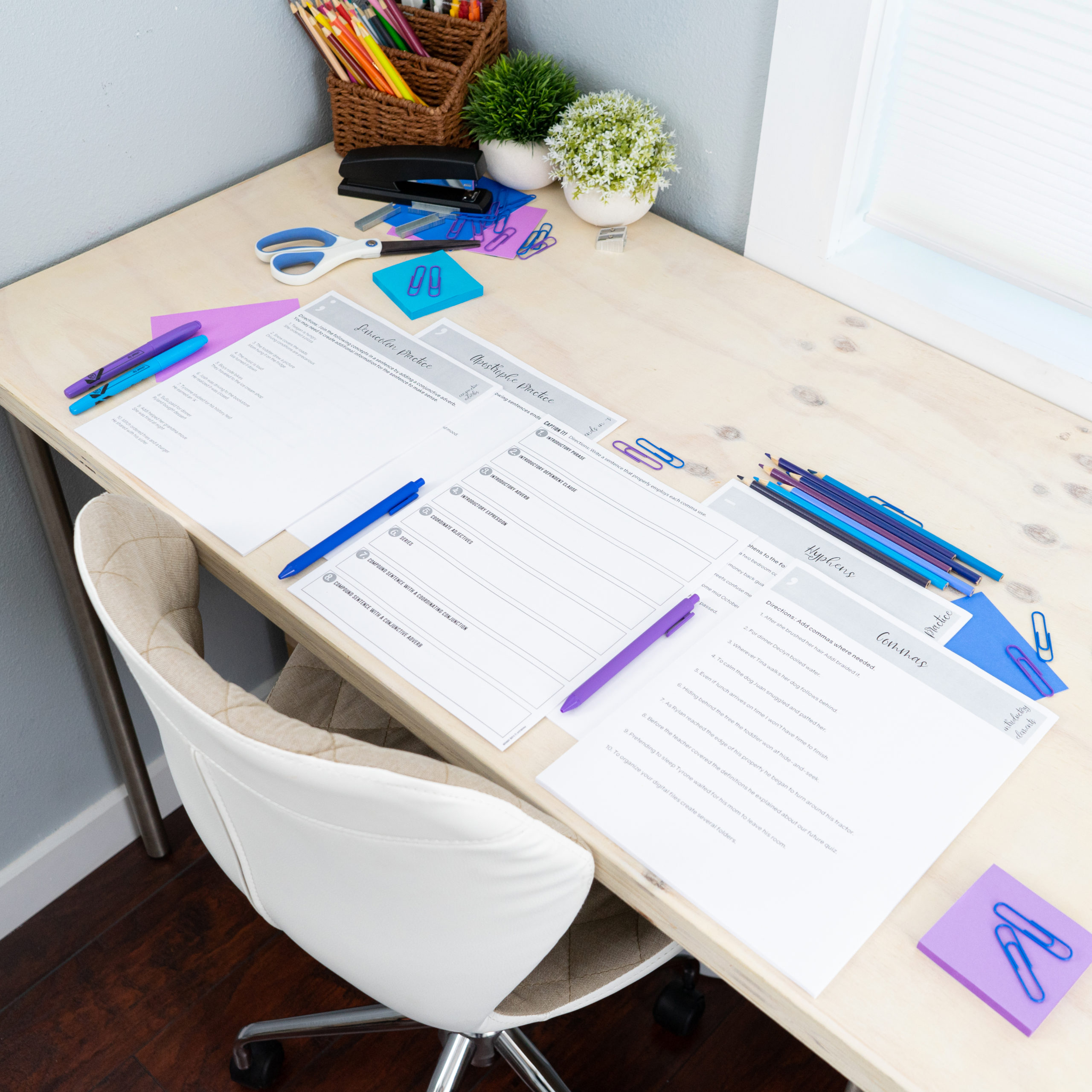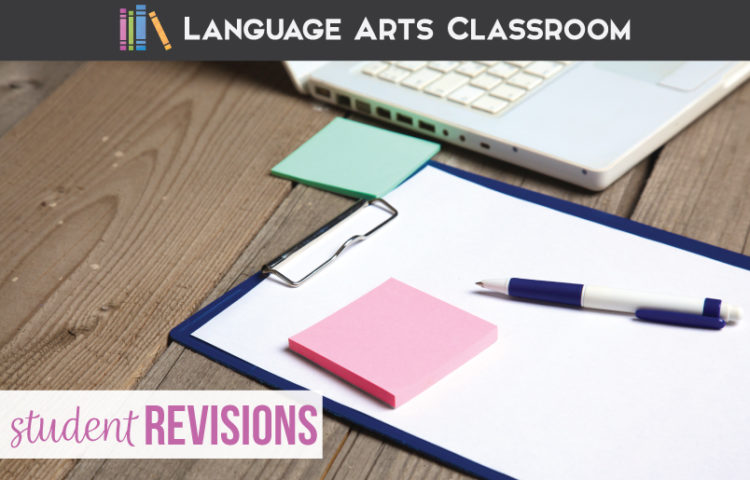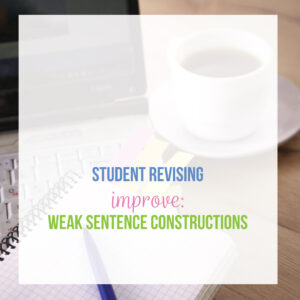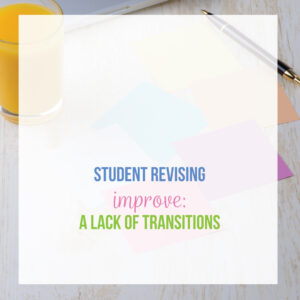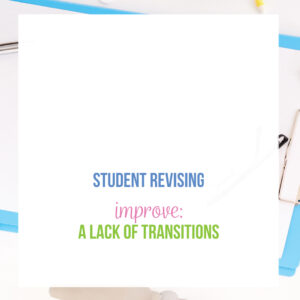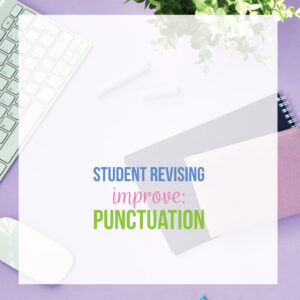The time comes in any writing lesson: the time for student revising.
I don’t draw a hard line between revising and editing. If we are editing and a student realizes that a paragraph makes more sense in different location, by all means—move it! Reflecting on my revising process with students, I still think that is the best approach. I can’t see older students thinking, “Ok now I am editing. Now I am revising.” I certainly don’t.
As students and I continue to work with our papers, we will improve in various ways, catch various errors, find various areas to clarify. However, the writing process breaks down revising and editing, and I do explain the distinction to students. When I explain the why behind our activities, students become more involved.
This breakdown of editing and revising helps my older students. Showing students pedagogical ideas can help students understand why we teachers have them complete certain activities. I’ve definitely found that older students are interested in why teachers ask certain tasks of them. A brief explanation can provide insight into how humans learn, making the entire process better for both sides.
So! The first step: getting student buy-in that revising is important.
Next, working with students toward clarity is the goal. I always tell students (and honestly believe) that they have strong, wonderful ideas. The ideas are seldom the problem in a student essay. Often, the problem is clarity. Communication of the ideas needs improvement. Often, but not always, this is where connecting grammar to writing becomes important.
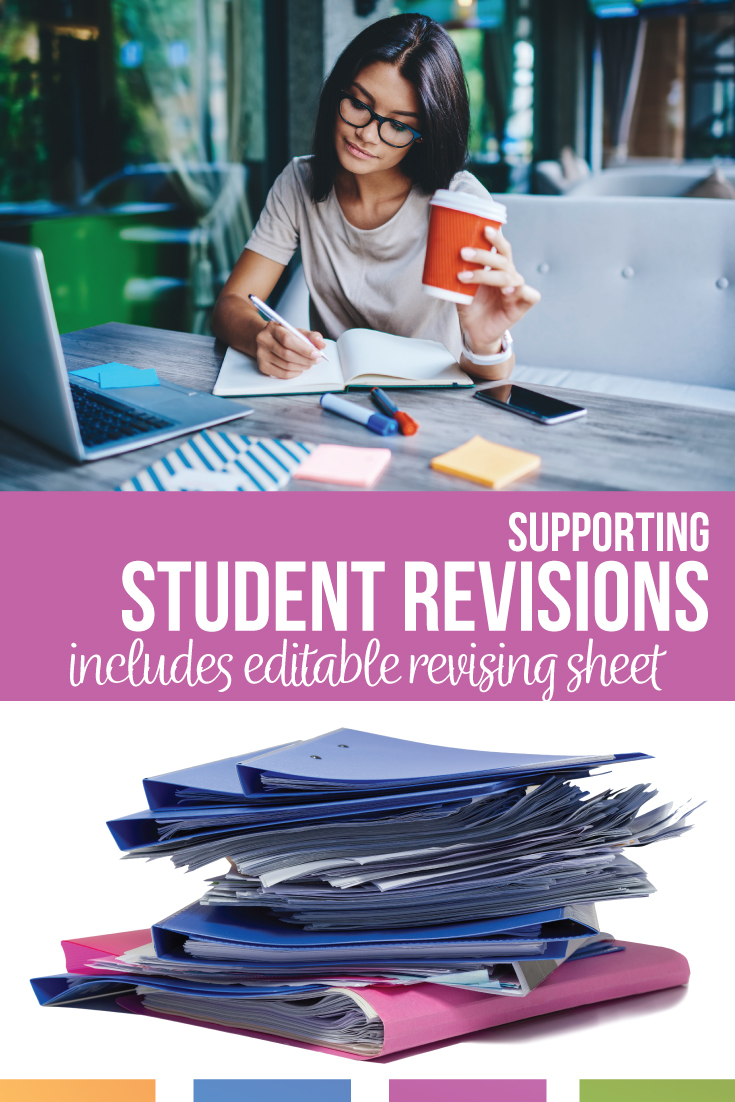
For this post, I’m considering this list my areas for revising:
- weak sentence constructions (there is/ there are/ subject, linking verb, predicate adjective)
- a lack of transitions, or weak transitions
- an abundance of adjectives and adverbs, or particularly weak modifiers
- correct punctuation
I’m sure every teacher has a different formula, but these four areas are my “umbrella” areas. Other revising areas are covered under one of these four. If you’d like a free download of my (editable) student essay assessment list, you can sign-up to see what guides me.
They also overlap a little. Below, I’ll talk about my process and talking points with students for editing and revising activities. You’ll easily see how these pieces are connected and that by improving one area, we are often improving all of them.
Weak sentence construction
Sentence construction problems can have a huge range, but I find that run on sentences and an abundance of simple sentences are the most common problems. Correcting these errors will require scaffolding and providing different goals for students.
The run on
The author states that global warming hurts our planet yet not enough is done and we must combat it however not everyone thinks that the situation is dire.
We’ve all read sentences like that. When I conference with a student with numerous run on sentences, I start with what the student knows. Sometimes, students can find subjects and verbs; other times, students can circle the conjunctions. If none of those options work, I ask the student to read the sentence aloud and when they come to a natural breath, we stop and review subjects and verbs.
Sometimes students get excited about writing and simply forget to add punctuation. These students might be able to discuss clauses and proper punctuation. Find where students are in the revising process and meet them there.
You might end up with many complete sentences, albeit simple sentences. If a student improves from run on sentences (or fragments and comma splices), that student has made improvements.
Overuse of simple sentences
Puppies are a big responsibility. Sometimes people adopt puppies without thinking. They cost money. They need taken out. They will damage your house. Puppies must have exercise.
Nothing is wrong with a simple sentence. Well-placed, a simple sentence can be powerful! Students who write an abundance of simple sentences are writing complete sentences (YAY!), but we can move them to seeing sentence structure as a powerful tool in conveying their message strongly, in providing transitions, and in gaining reader engagement.
To maintain a reader’s interest, sentence structure must add spice. Ask the students if any of the ideas are similar, if any of the ideas relate to each other, or if any of the ideas affect each other. A few well placed conjunctions will lead the reader to understand the writer’s point of view—any writer’s goal.
At this point in our work, this is where I grammar-geek out. Our understanding of language perfectly connects grammar to writing with sentence structure. What conjunctions? A subordinating conjunction might show a cause and effect relationship. A conjunctive adverb might give the reader pause. Experiment with the student, showing the power of grammar:
Puppies are a big responsibility; unfortunately, during adaption, people don’t always consider the responsibilities. (conjunctive adverb)
Puppies cost money, both with veterinarian bills and damaged household items. (correlative conjunction)
Although providing exercise and taking puppies out regularly will offset some energy, puppies will still require time from their owners. (subordinating conjunction)
All of those sentences are correct! Build a variety of sentences with students and experiment with the effect of each. Get students to that higher level of thinking by evaluating the effect. What sentence coveys their message in the best way? Why? Which type of sentence best provides impact? Ask students to choose, and empower them in their knowledge of grammar.
Make student revising meaningful by diving deep. You normally can find a spot to meet students. If students only use one conjunction for simple sentences (and, but), push students to experiment with a new one.
Lack of transitions
A lack of transitions can confuse readers. Weak transitions can minimize the writer’s message. First, second, and third are transitions, but they don’t provide much punch.
When I conference with secondary writers, I explain that I don’t want them to merely read through their papers and haphazardly add transitions. As we discuss sentence structure, we do cover transitions a bit because a variety can show relationships between ideas. Purposefully placing transitions requires some thought. Ask:
- What are your biggest takeaways in your paper? Where are they?
- At what point do you have an idea that you want the reader to remember?
- What piece of information is important, but it might seem unimportant upon first glance?
- Is there part of your earlier paper that will be important later in the paper?
Students should own their papers, should understand the nuances that each point has. Once they can answer questions about the purpose of transitions, they can weave transitions into their papers.
I work with students that a transition can be so much more than a simple word. Sentences can connect ideas for readers. A transition sentence can lead one paragraph to the next. If a concept is large enough, a transition paragraph might even be appropriate.
Finally, transitions take some time to cultivate. Since I want secondary writers to experiment with their essays, I stress that during writing conferences. Together, for example, we will write two transition sentences. I’ll model my thought process as I work through transitions. Those two sentences we write? We might combine them. We might use part of one. Maybe one completely connects the student’s thoughts. We might scrap both of them and develop a new one. The process helps make student revising meaningful.
Weak Modifiers
When I wrote my first book, my editor and I were improving drafts. He once sent me a simple message:
Stop using adverbs.
Maybe I like adverbs? Who knew?
Anyway. . . modifiers are tricky. Writers might use too many of them, or writers might overuse incredibly simple ones like very, too, and quite. The problem is that when writers overuse modifiers, the words don’t provide a huge impact like we’d expect from them.
Actually, well-placed modifiers provide great impact because readers aren’t accustomed to tons of descriptions.
So first, I talk with students about modifiers; I share my background as part of the anticipatory set. Any time that I explain to students my process and struggles with writing, I see student buy-in increase. The idea that I too am a writer, that I too struggle, that I too must return to draft after draft and edit, marking out weak modifiers. Share your writing journey, even if you primarily write emails or papers for graduate school.
Next, ask students to find their adjectives and adverbs. Students might not be aware that they rely on adjectives and adverbs to convey their message. If students highlight their modifiers, they might be surprised at how often they appear. Then ask students to look at the verbs by the modifiers. Ask students to make their verbs do the work.
For example:
Gibson is loud at the game. (adjective)
Gibson loudly yelled at the game. (adverb)
Neither of those sentences are problematic, but you might push a student to investigate verbs. If a person was at a game, what verb would explain the loudness? Brainstorm, knowing that no answer is wrong: commotion, screamed, sparked, angry, upset, stood, exclaimed.
What verb or verbs might best explain the situation? Of the modifiers listed, are there verb forms?
Gibson stood and screamed at the umpire during the baseball game. (compound verbs)
Standing, Gibson exploded at the umpire. (participle, then a new verb)
When working through student revising, empower students to use their knowledge to improve their papers. Student essays can have an assortment of troublesome areas, but having weak modifiers is normally one where students can see vast improvement. Most students understand adjectives and adverbs, and with a little prompting, most can develop a list of power verbs to replace some of those modifiers.
Incorrect punctuation
I saved correct punctuation for last because normally at the end of a student revising session, we have worked through all of punctuation errors. For instance, sentence construction requires proper punctuation, as does fixing modifiers with introductory modifiers and coordinate adjectives.
Punctuation might be considered “editing” because it falls under grammatical errors. “Grammar” can be a wide net, and student revising encompasses more than grammar, dependent upon what you classify as “grammar.” For instance, some teachers label confused words and spelling as grammar, and others don’t. Hopefully by this point in the writing process, students have added stray periods. They might not have, however, rearranged a sentence and added a comma or turned numerous simple sentences into a compound sentence with a conjunctive adverb.
Often, punctuating citations trips up students. (At this point in the writing process, you have probably covered your citation guidelines.) For revising purposes, refresh the rules.
As a group, narrow the focus for students. For example, ask students to look at their citation of an author from a book. Model where the period, parentheses, and comma belong. Then continue with another common citation, such as a website with no author. Correct the punctuation for the most common missteps, and then conference with specific situations.
So at this point, my students and I have worked out punctuation errors, but we still might need to work through our papers one more time. Additionally, using a variety of punctuation is a great way for connecting grammar to writing.
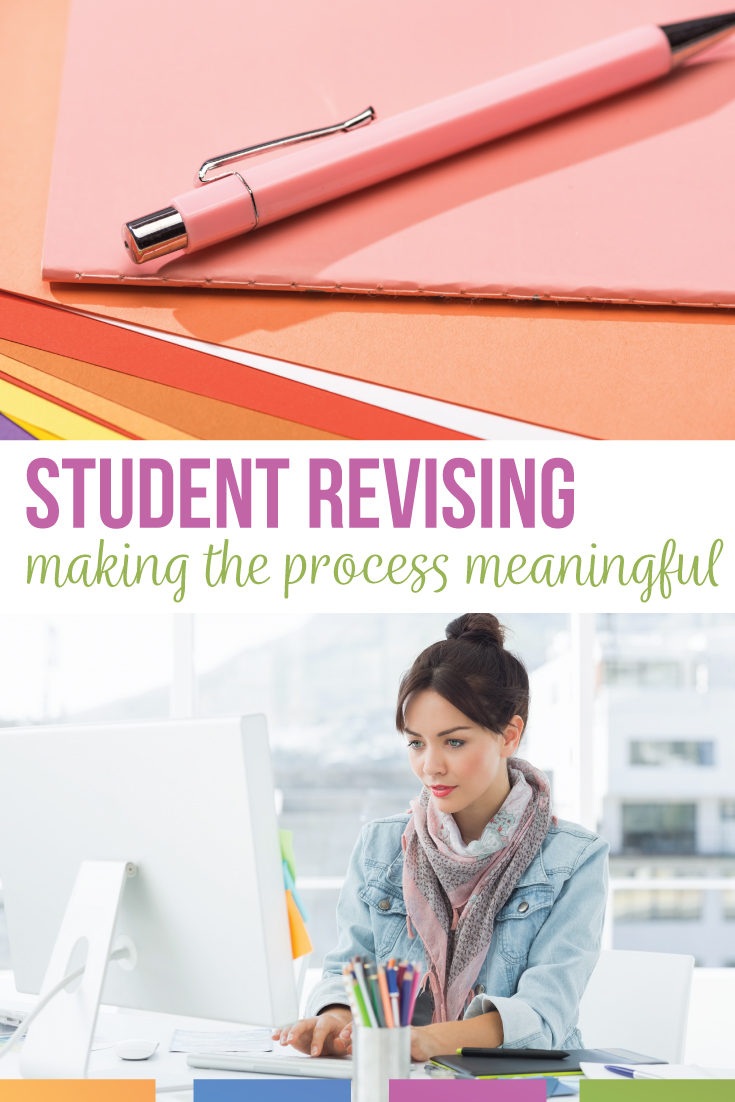
The final read-through of a student essay might be a combination of editing and revising. I always tell students that writing a paper is an art. They are crafting an art piece; they are molding and shaping an artistic piece.
As we work through papers together, I continue to ask questions. What conclusion would a reader who agrees with you think about these points? Where would someone disagree with you? Even if students are writing an informative paper (and not an argumentative one), readers could poke and question. Point out those considerations to secondary writers and supply a potential route they might take with their writing.
Like I mentioned, these four areas do help me make student revising meaningful, and many of them overlap. I work to address these concerns and provide choices for solutions in my writing bundle that contains interactive activities for use in digital platforms.
Are you ready for the next part in the writing process? Editing is next.
